
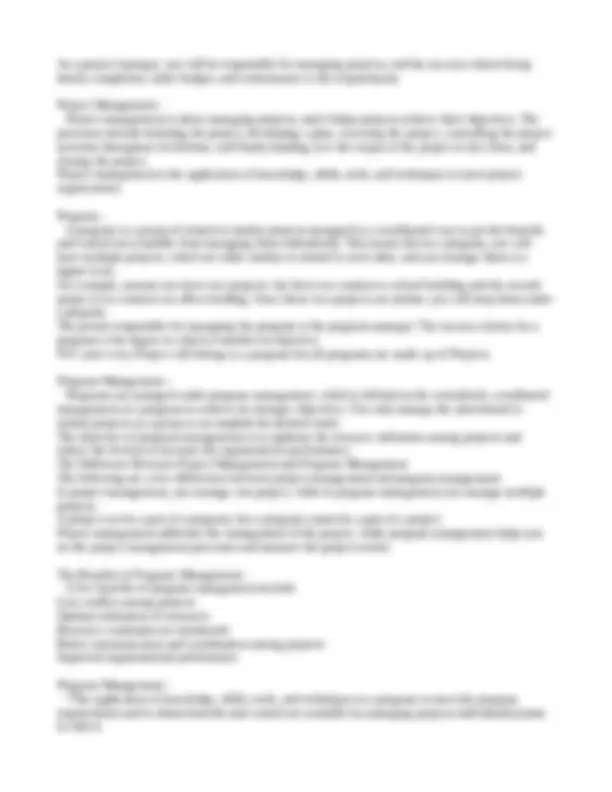
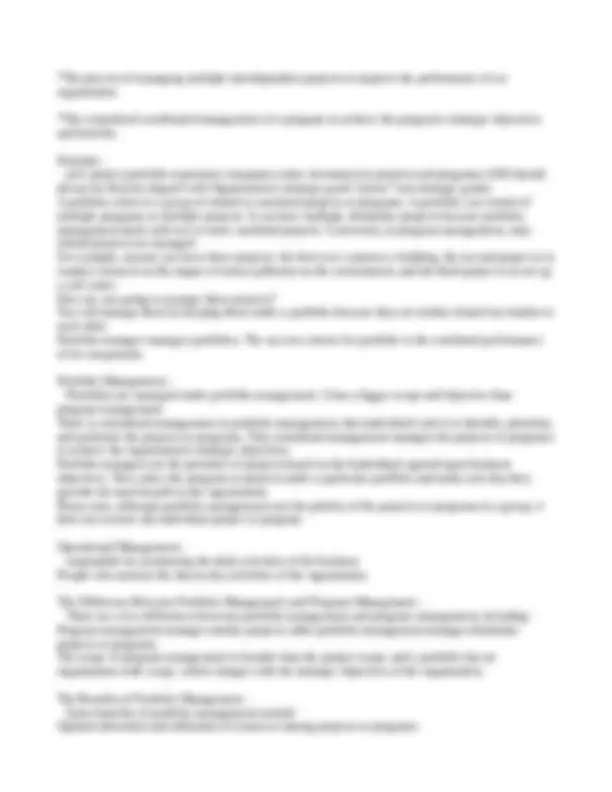
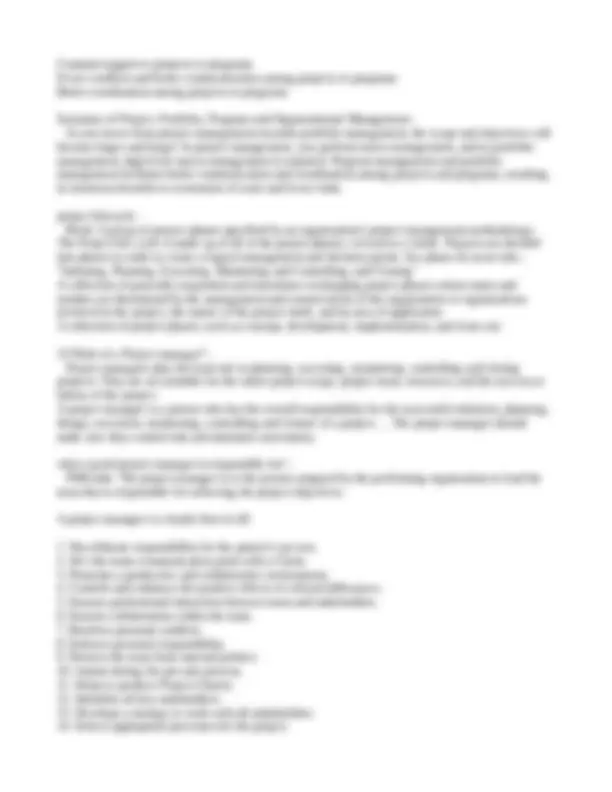
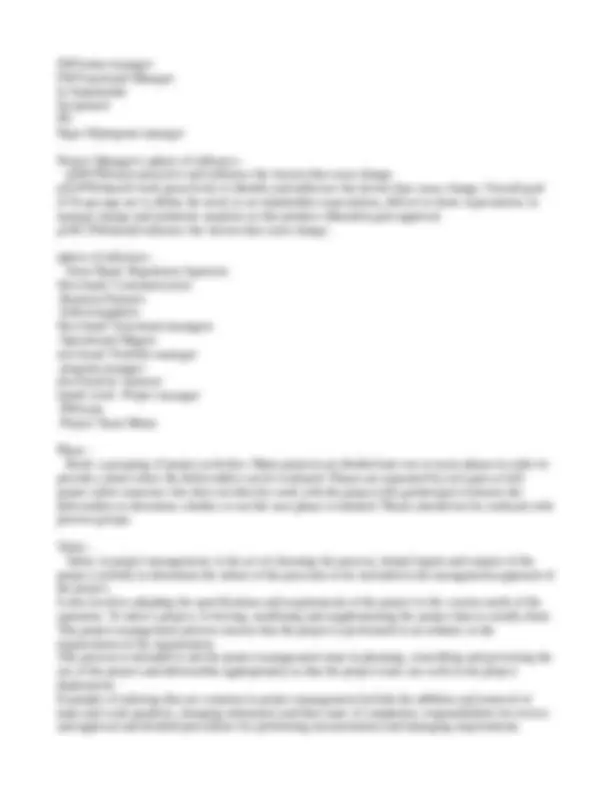
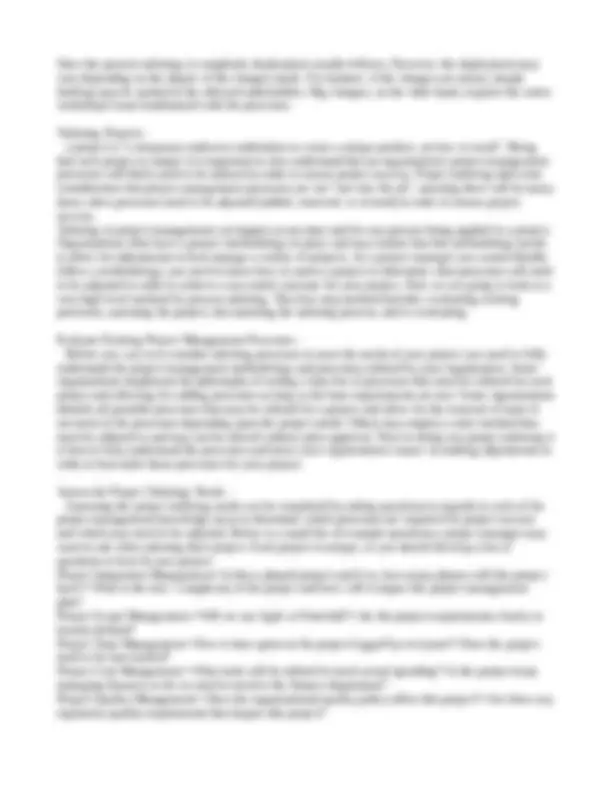
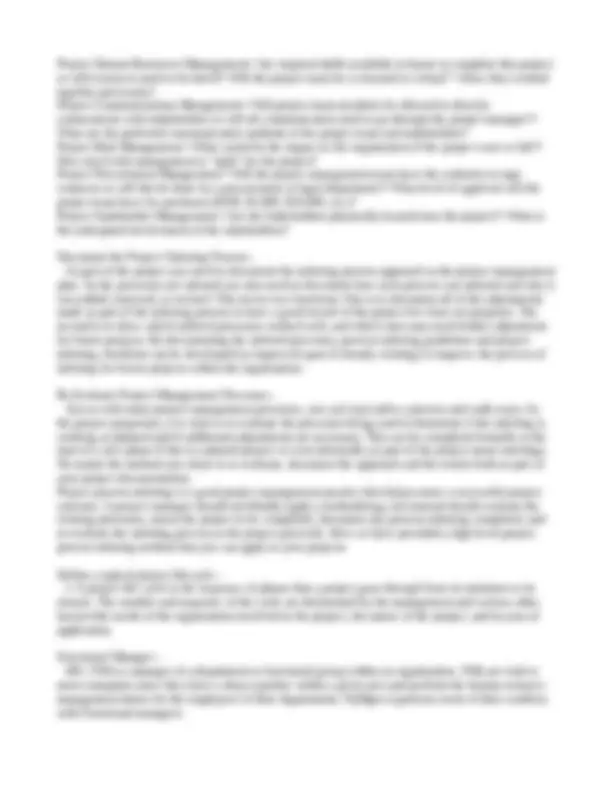

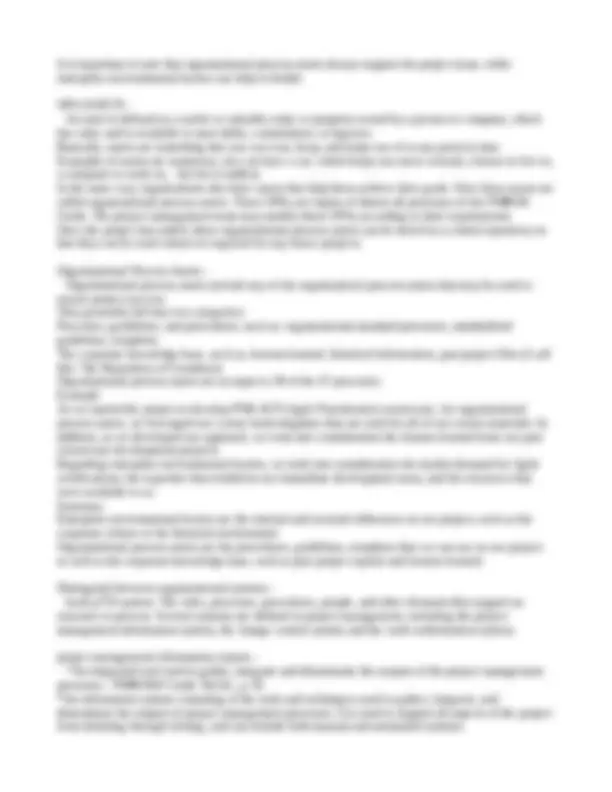
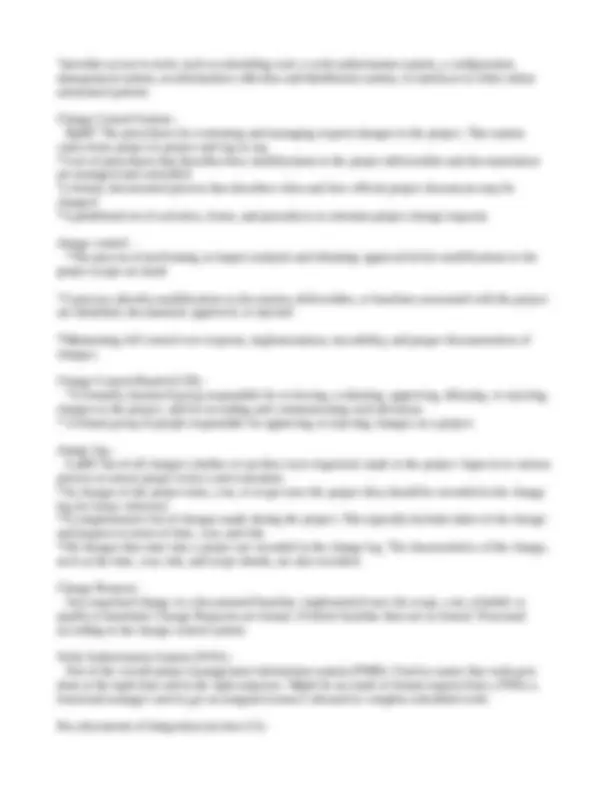
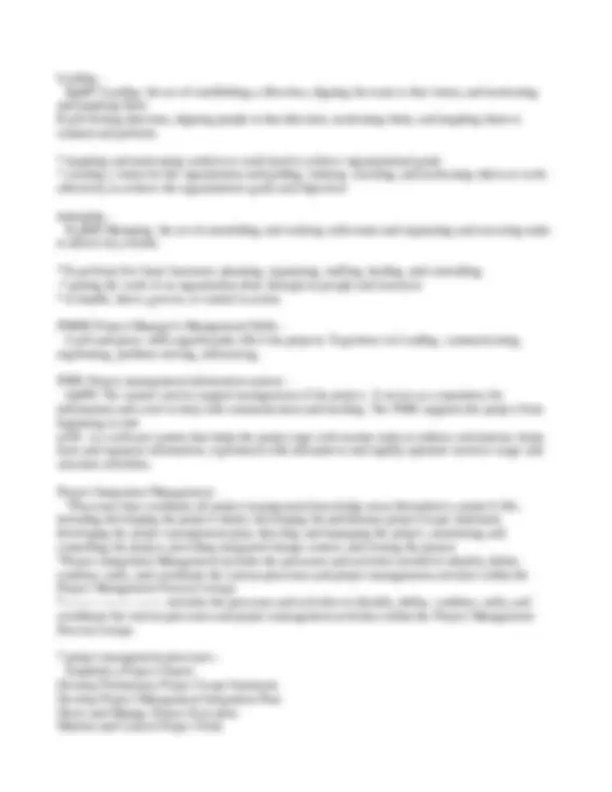
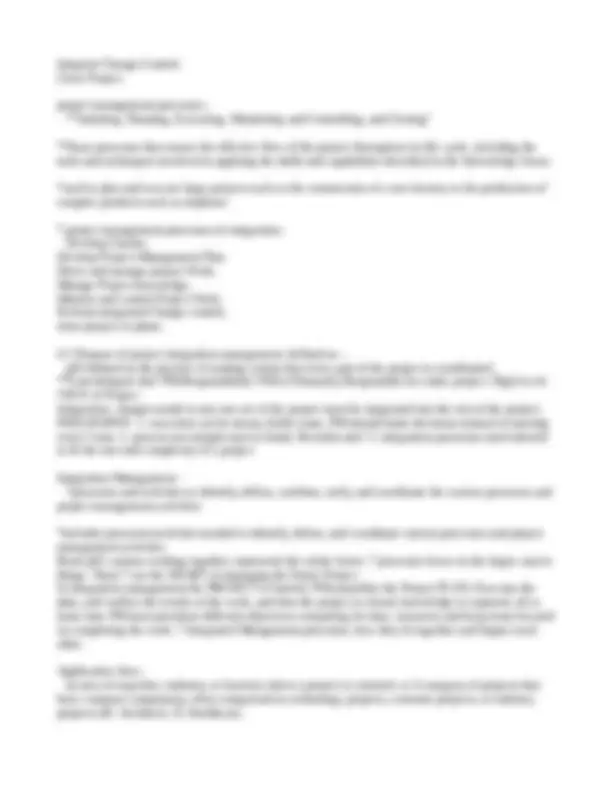
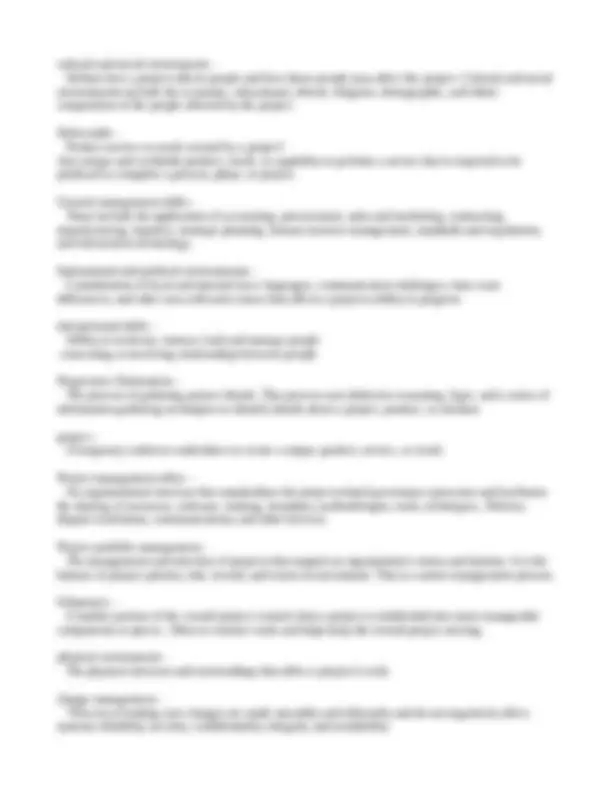
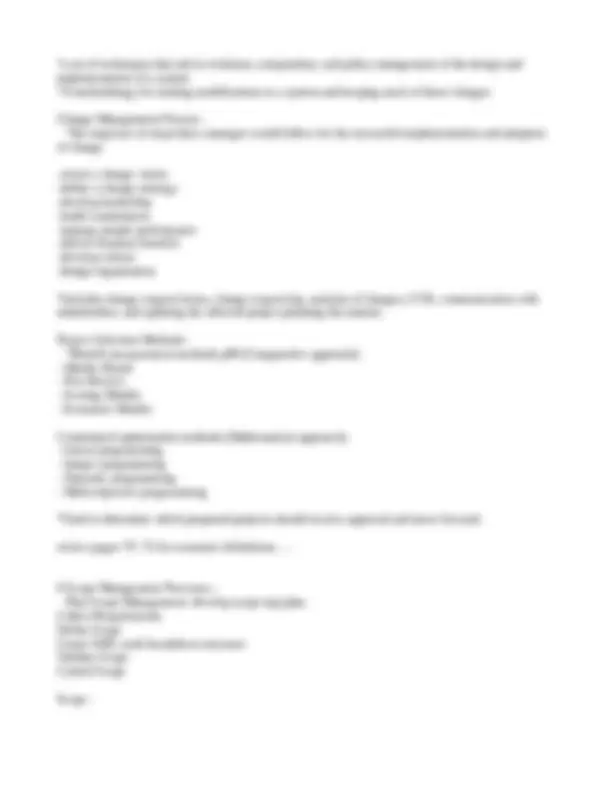
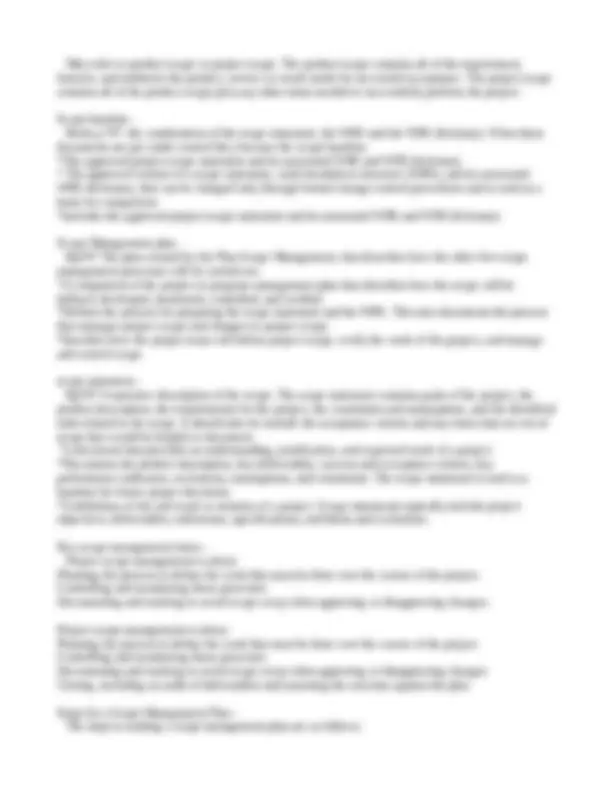
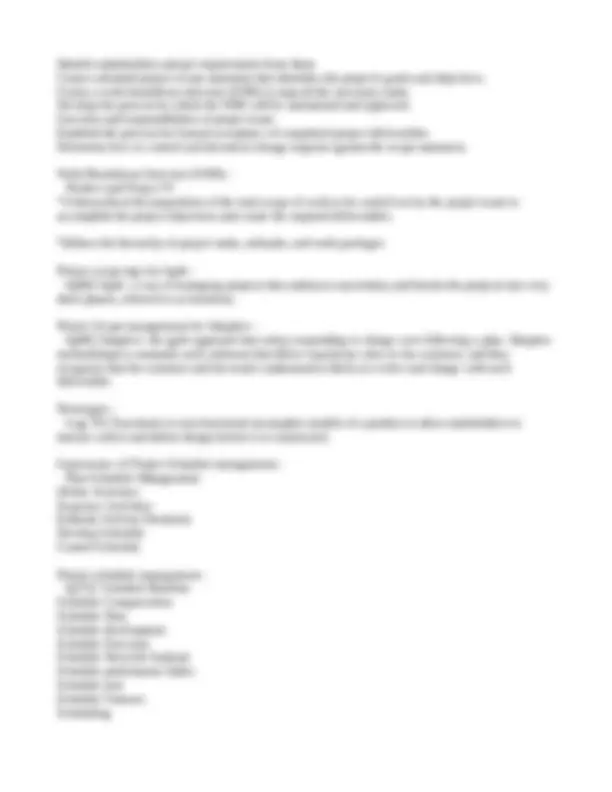
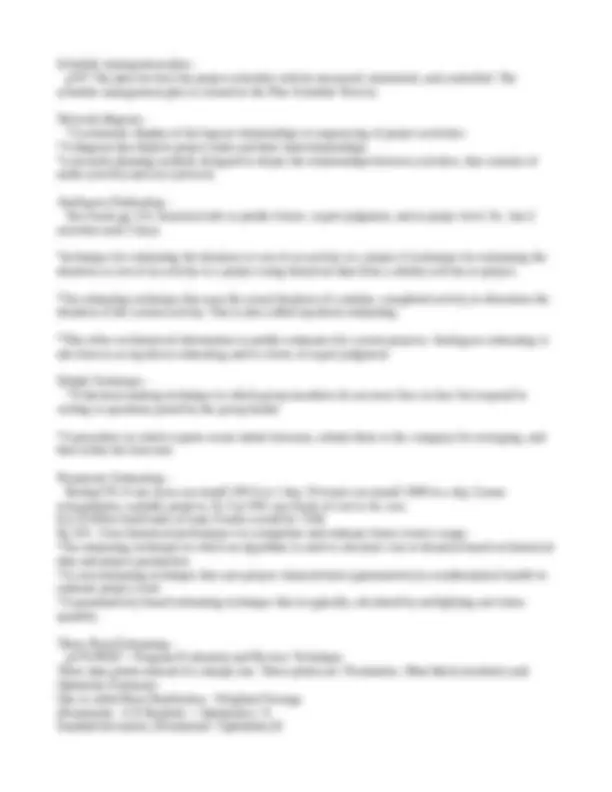
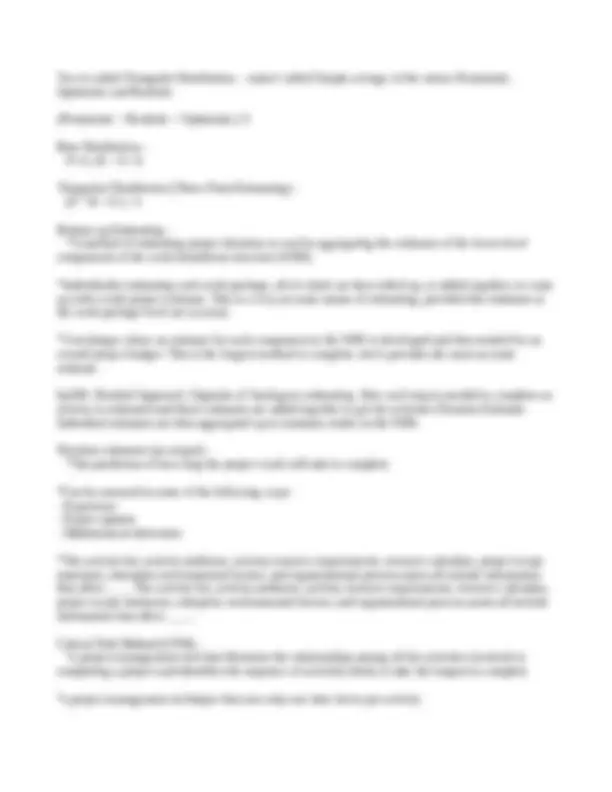
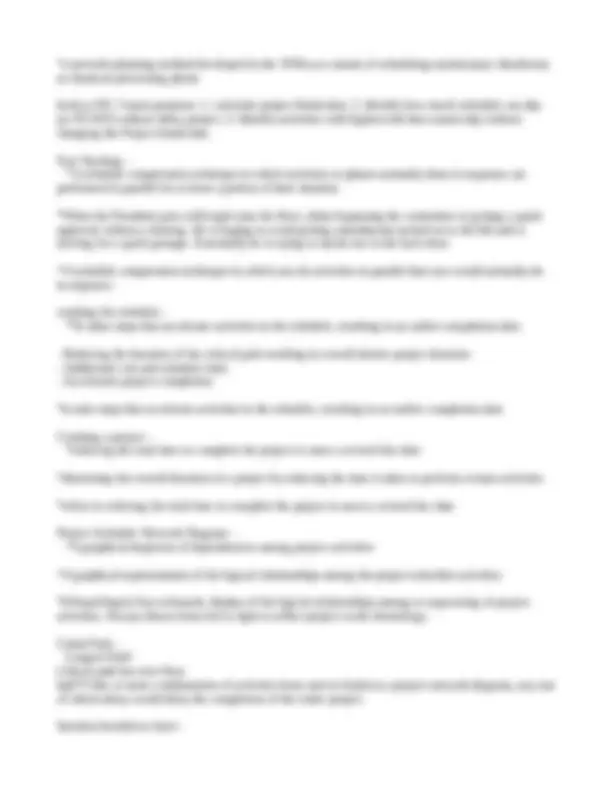
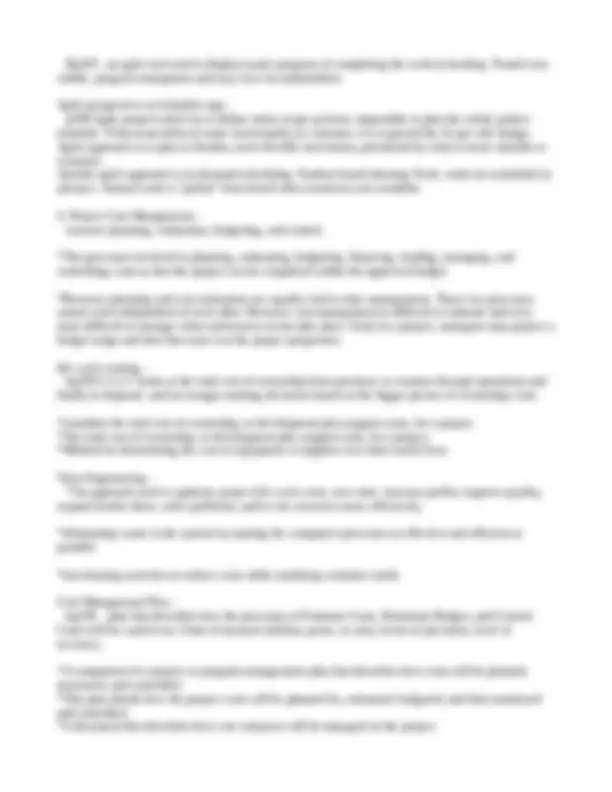
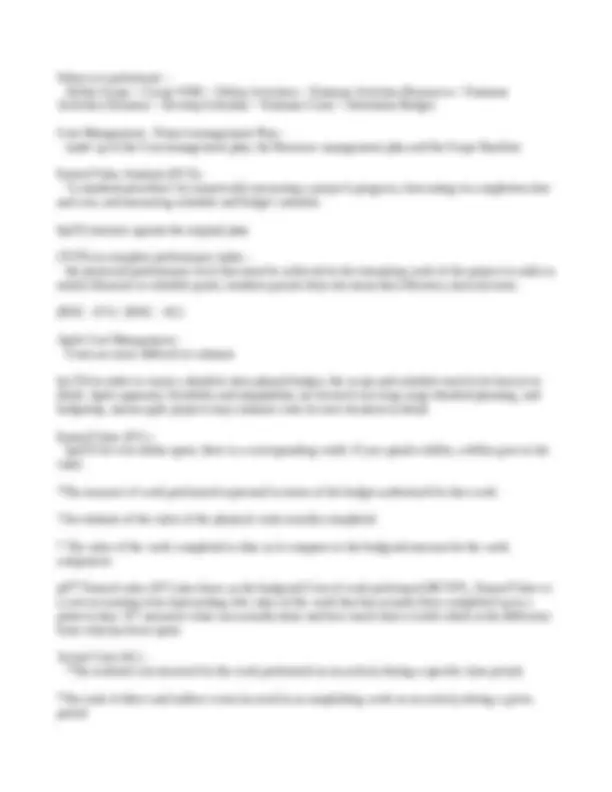
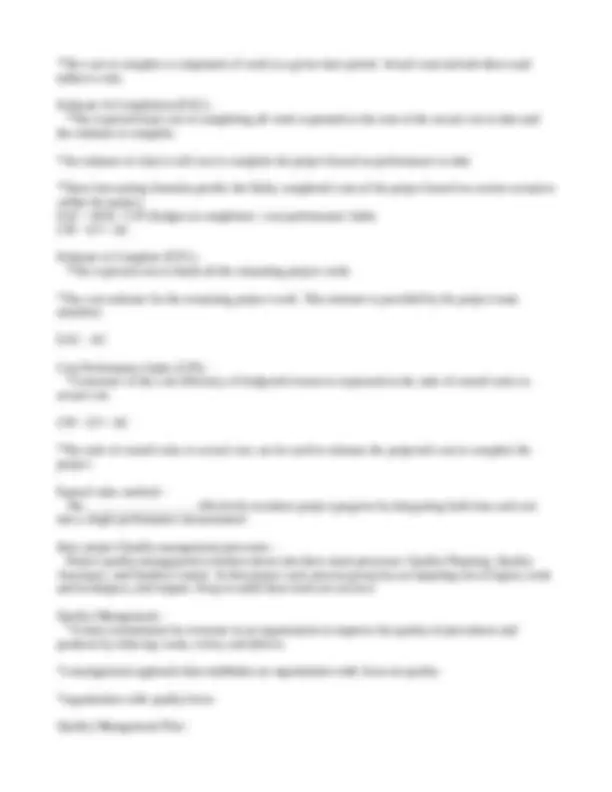
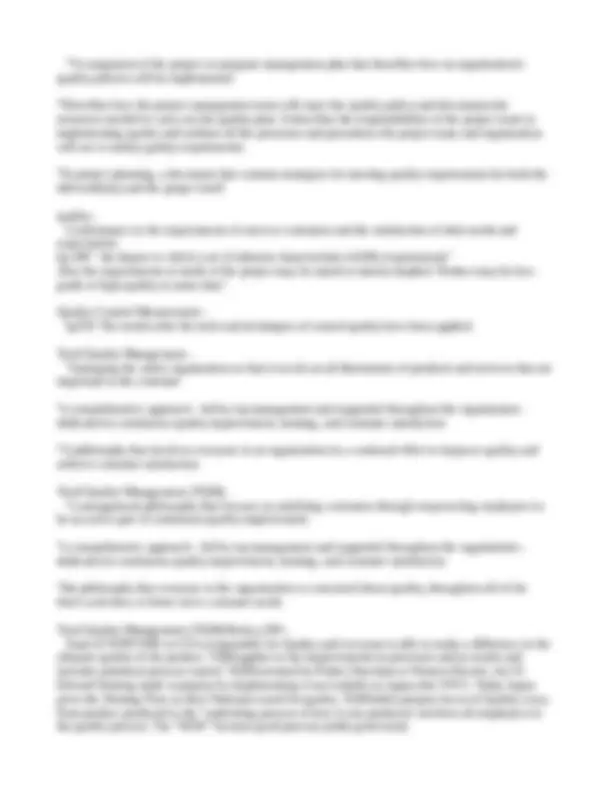
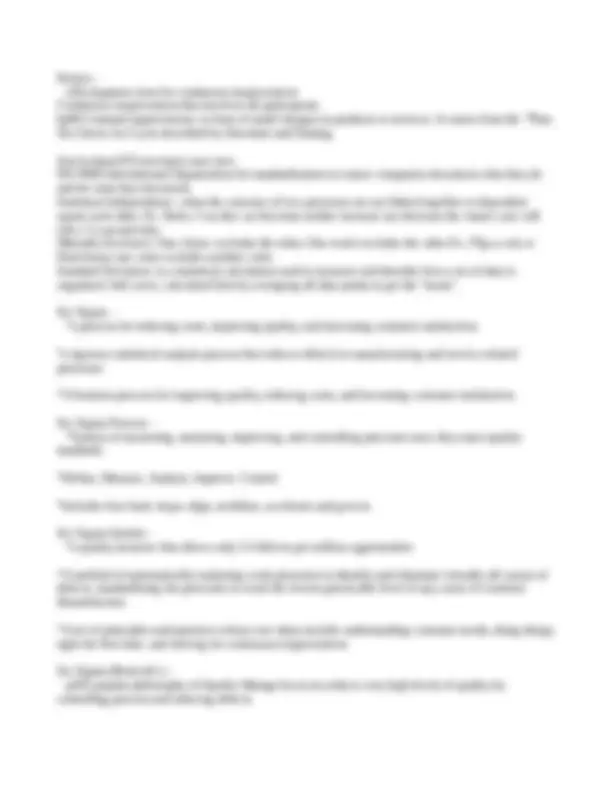
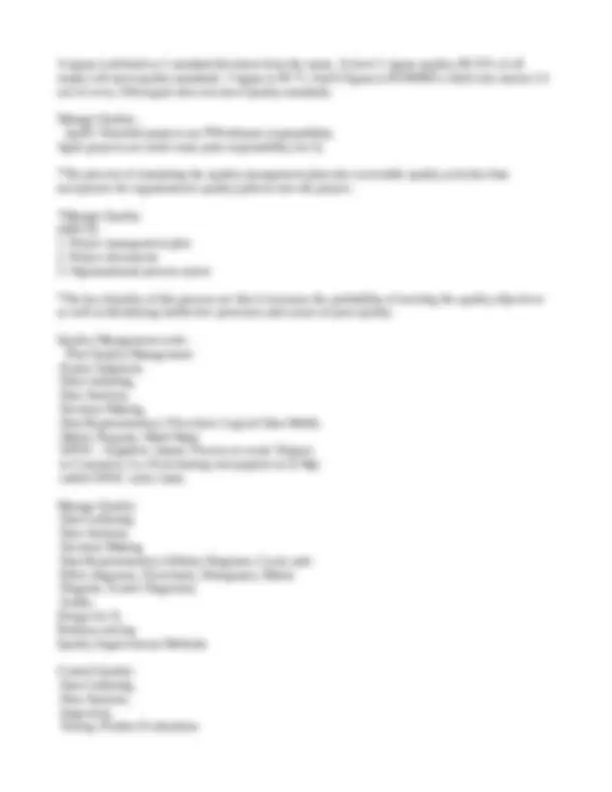
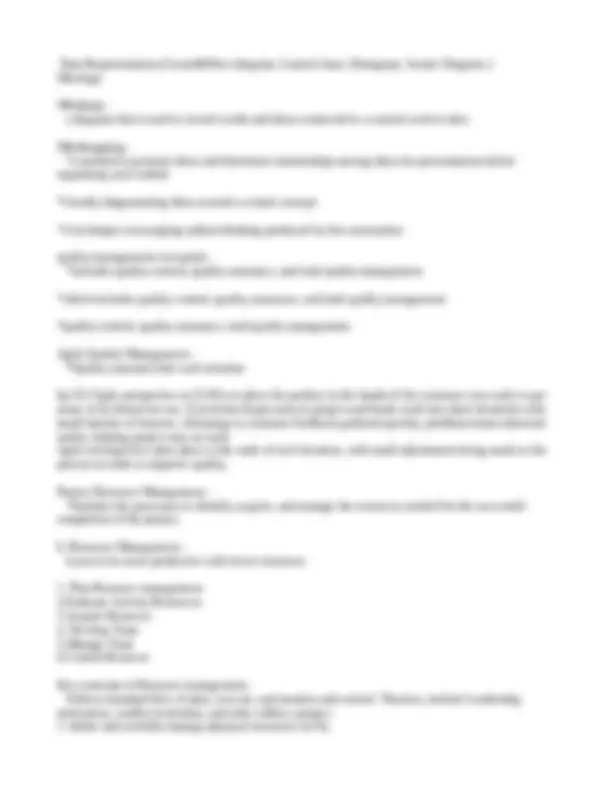
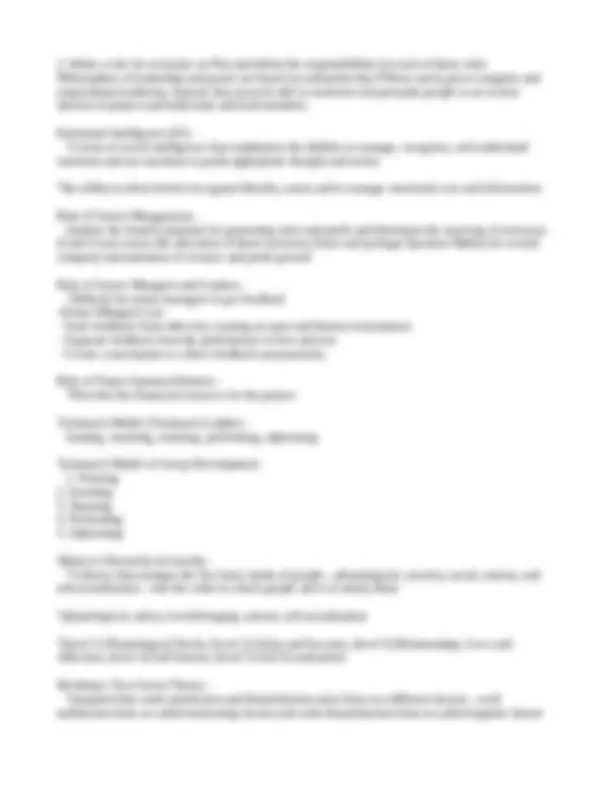
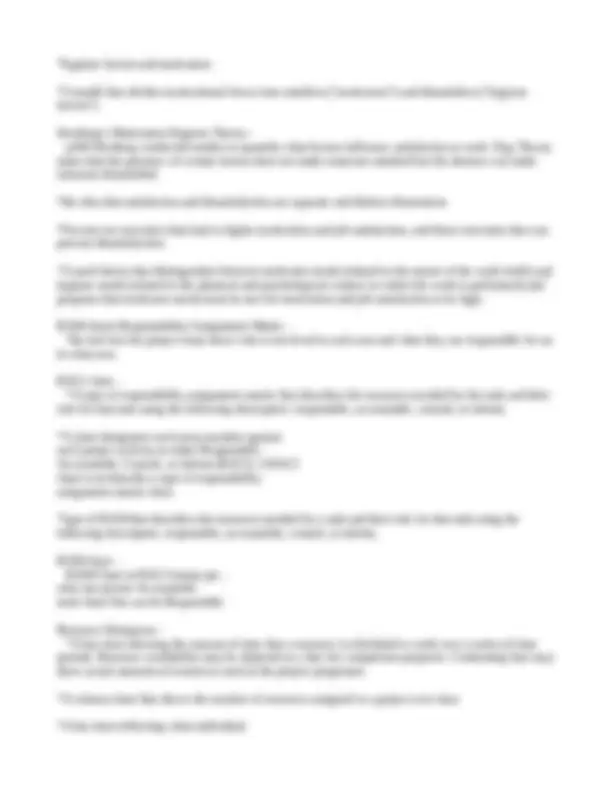
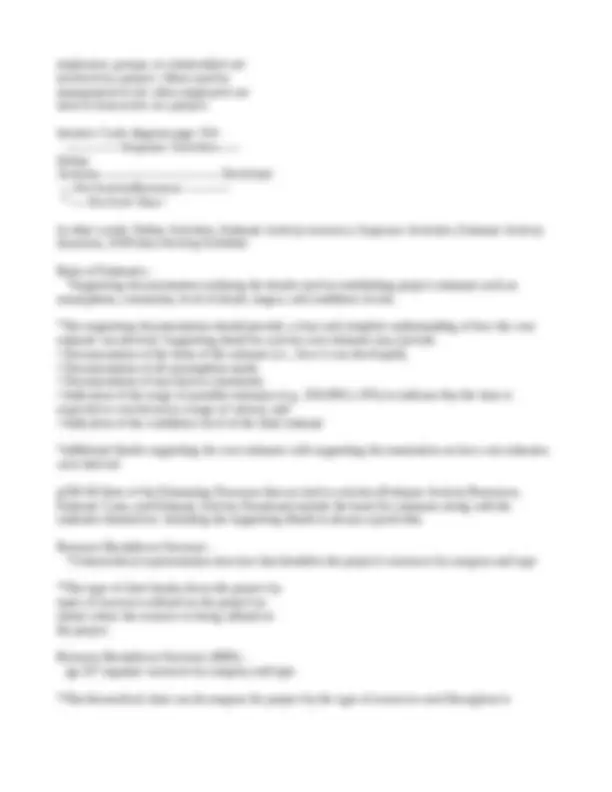
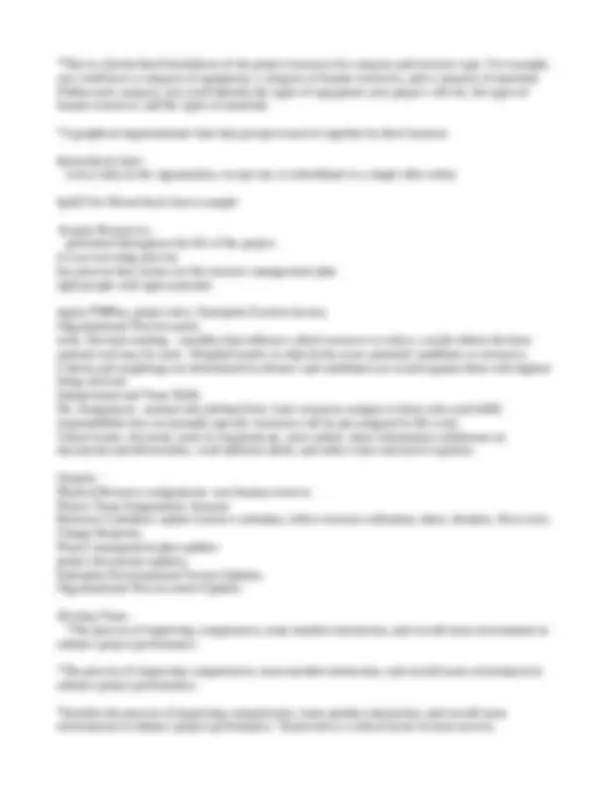
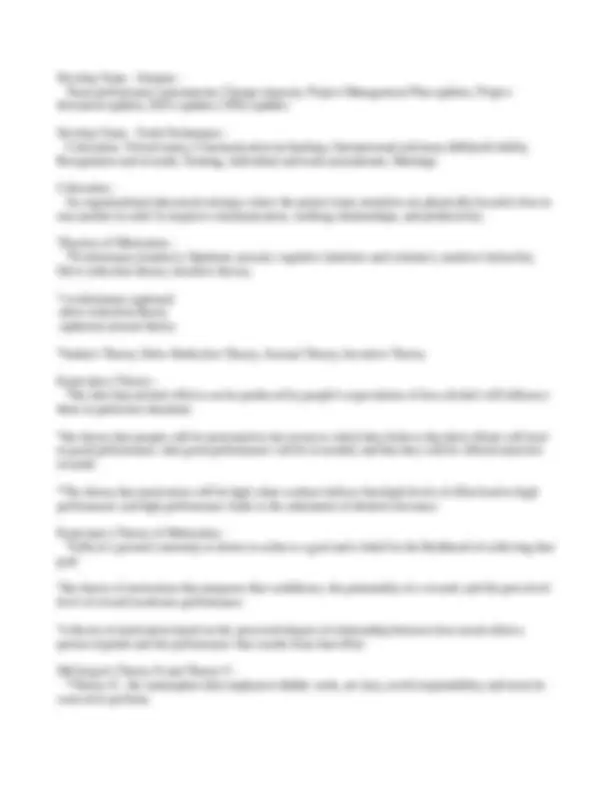
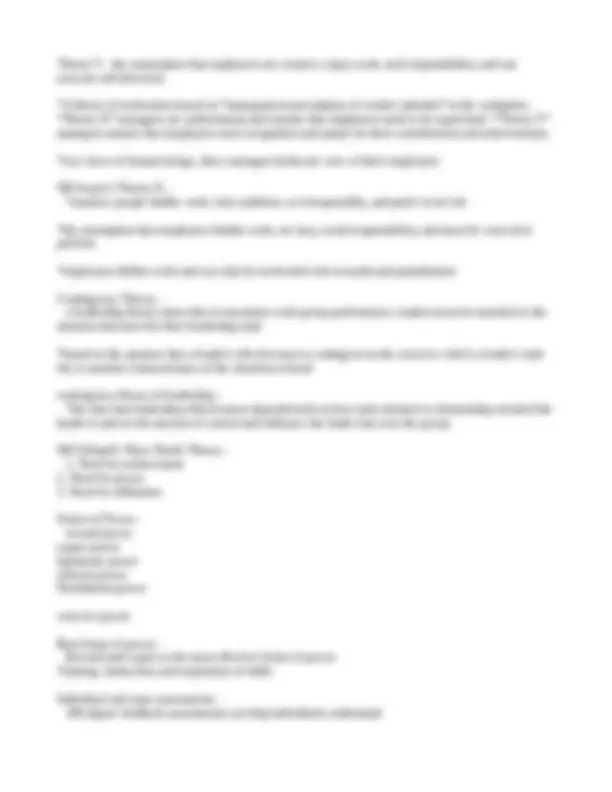
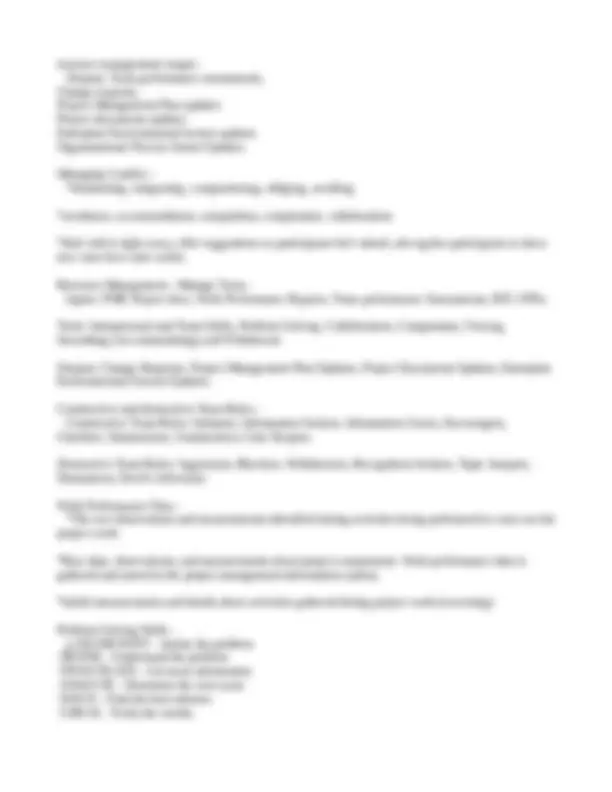
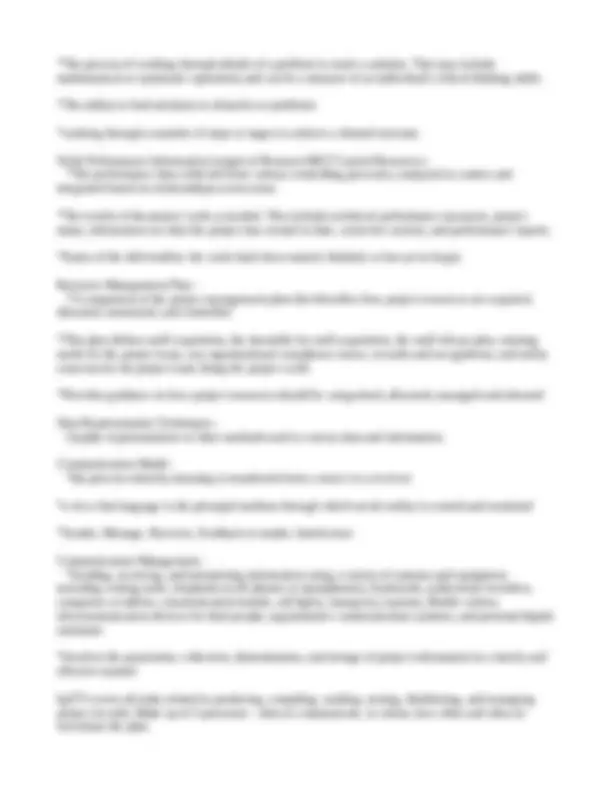
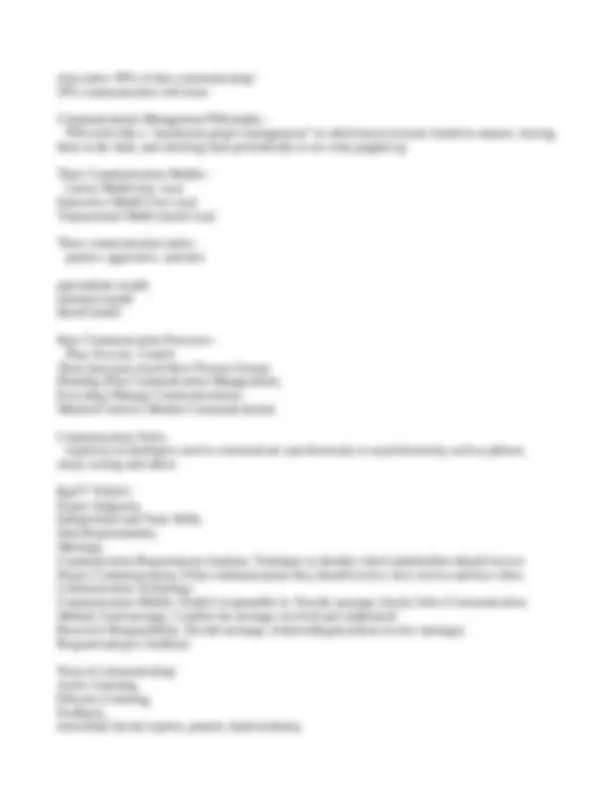
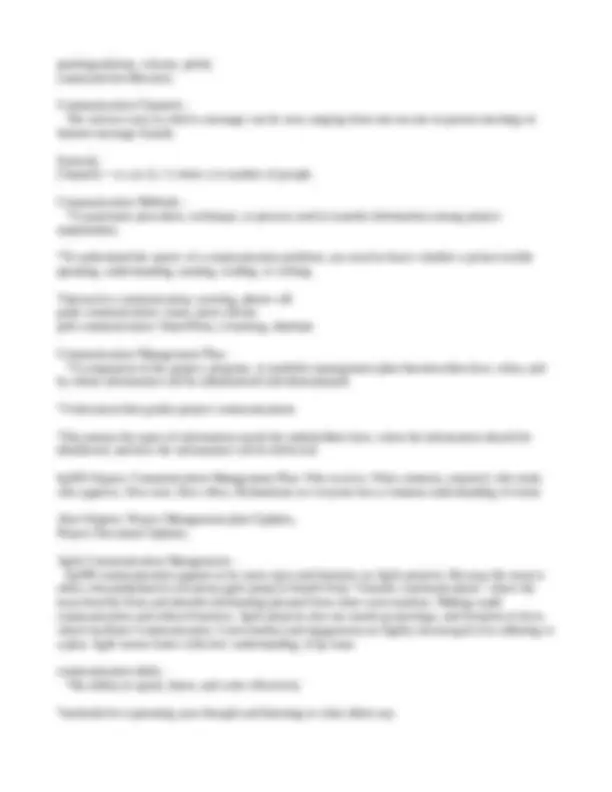
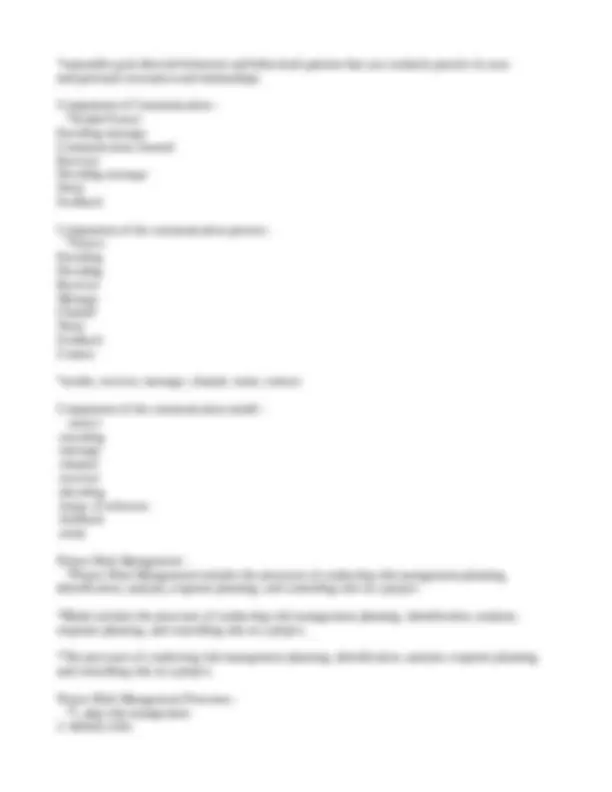
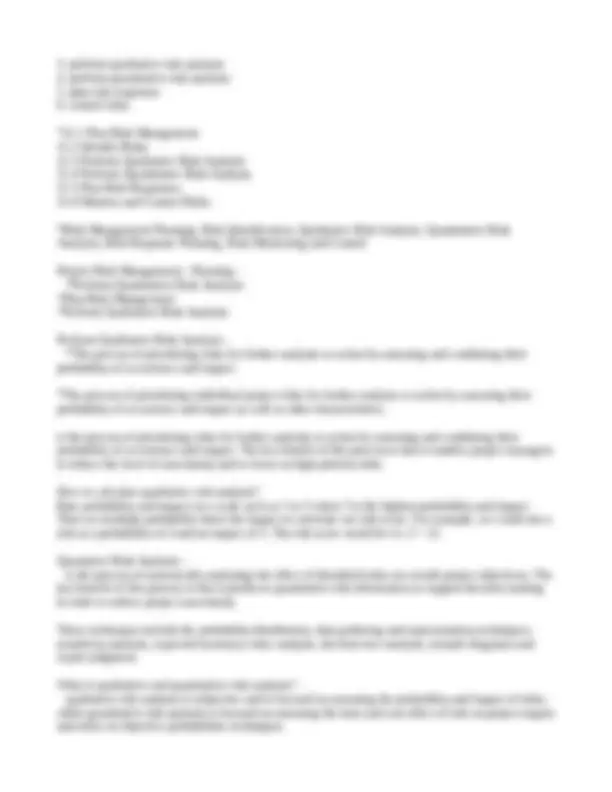
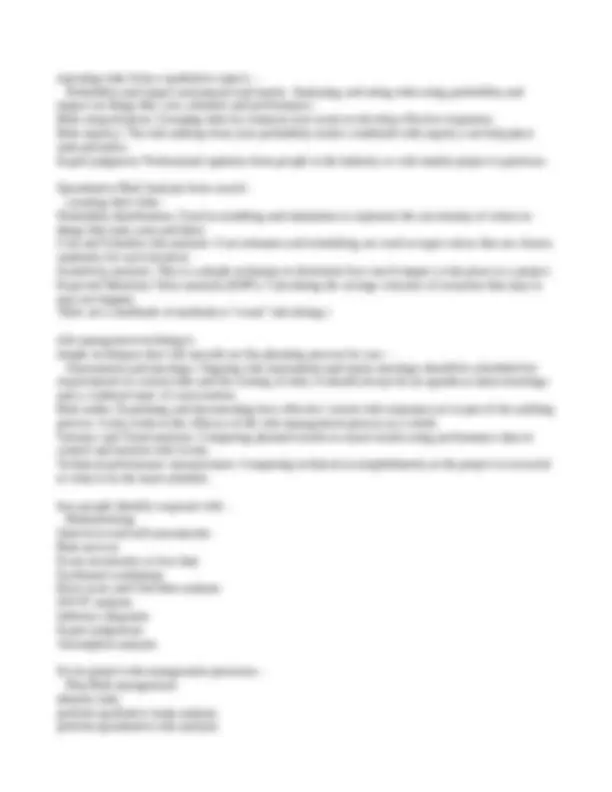
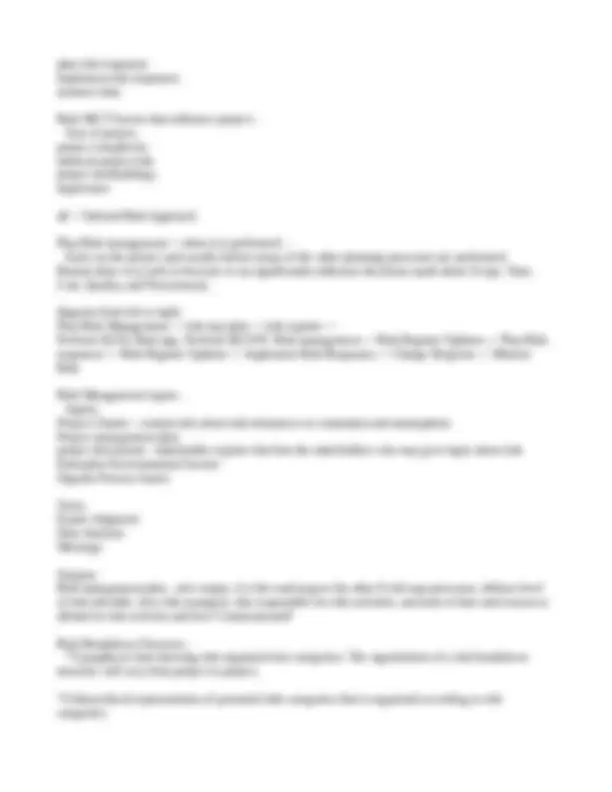
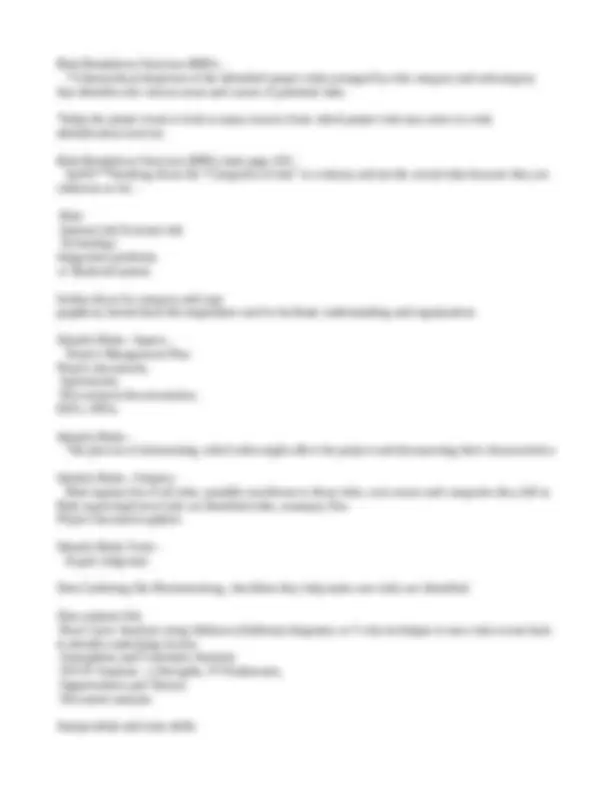
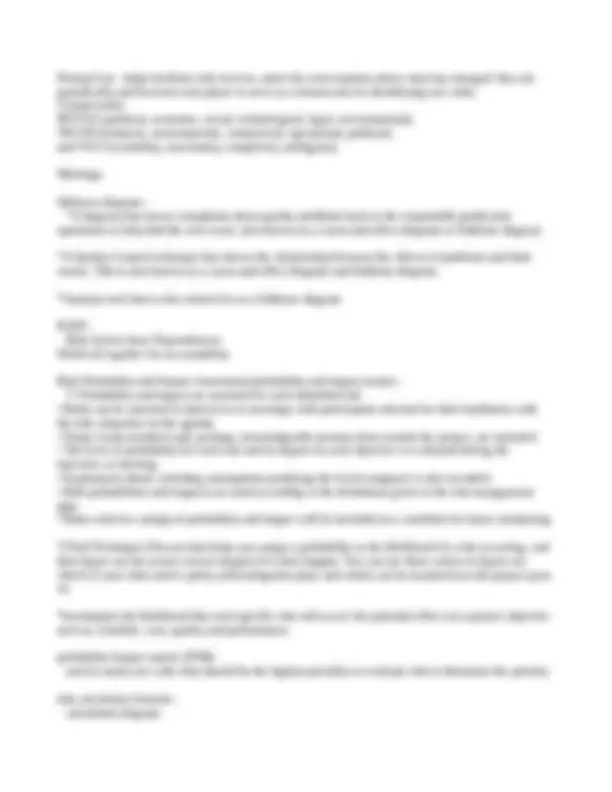
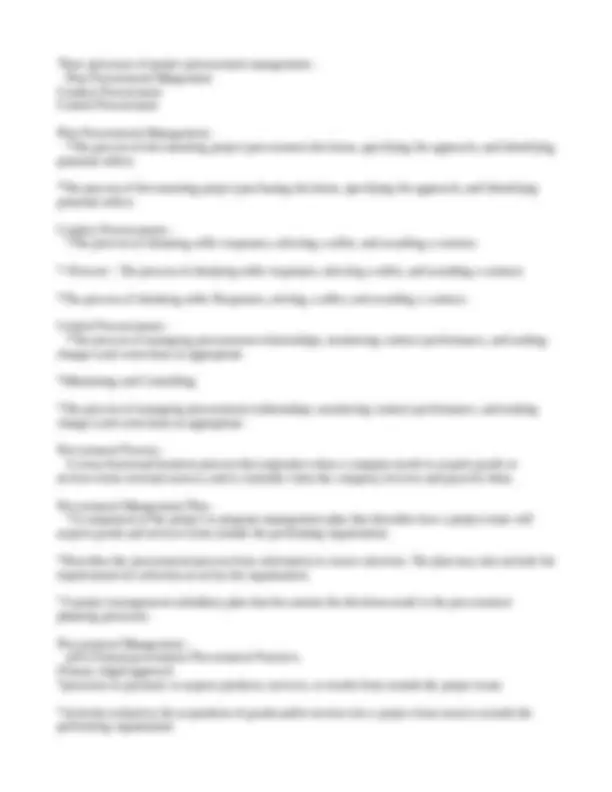
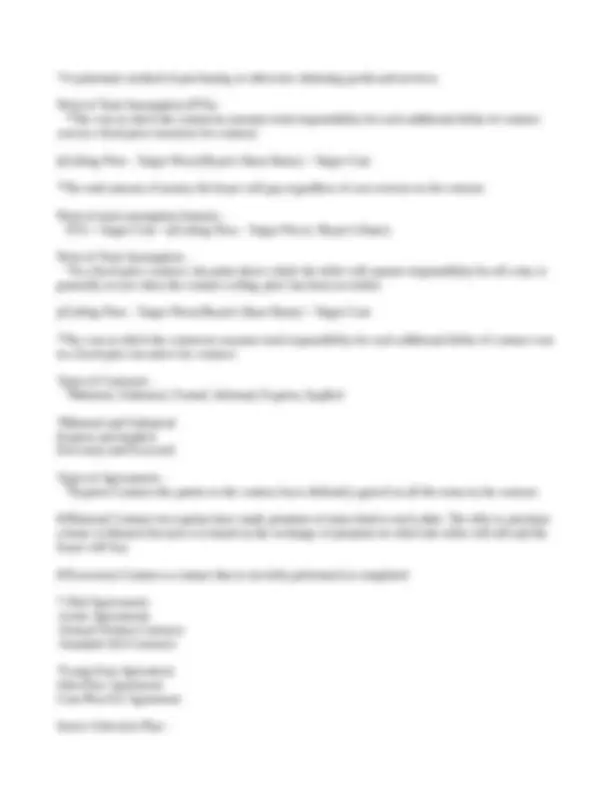
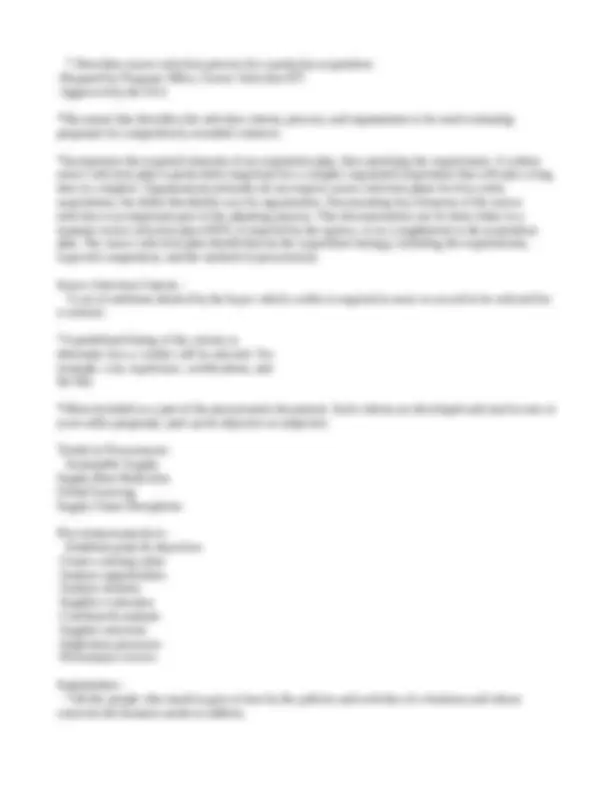
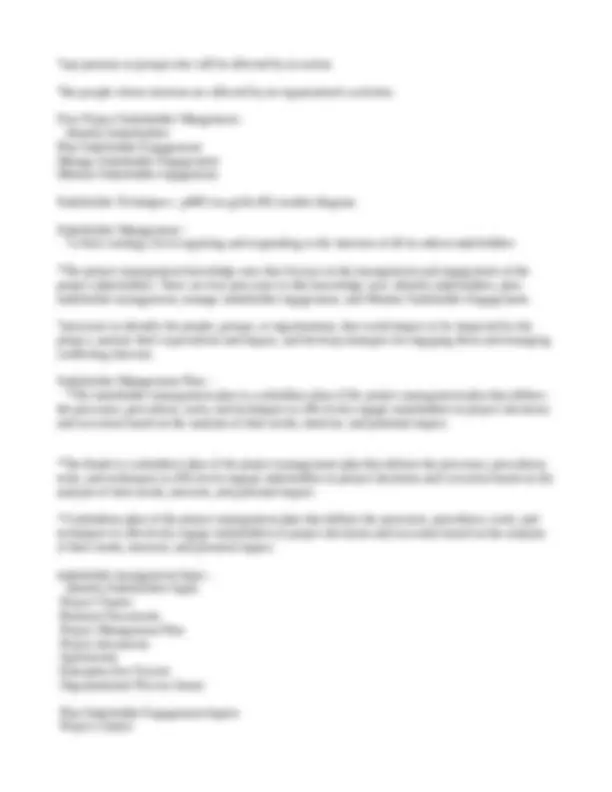

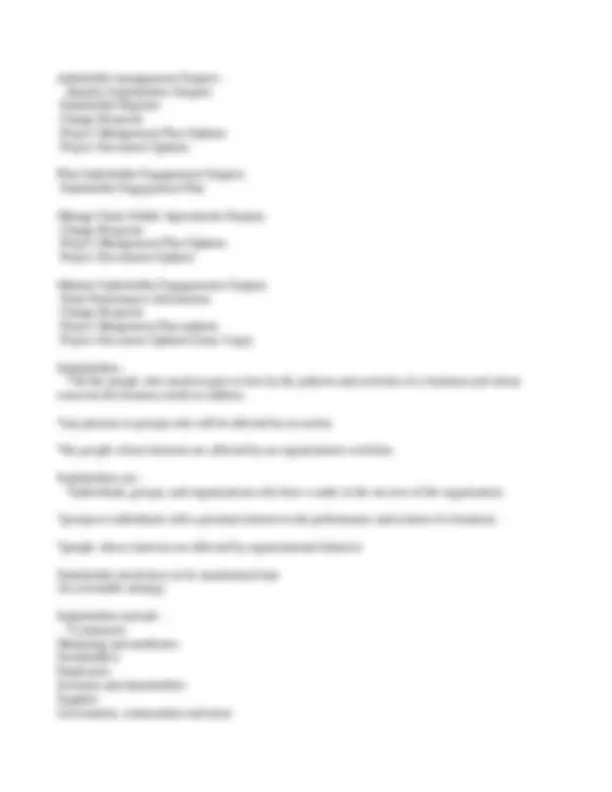
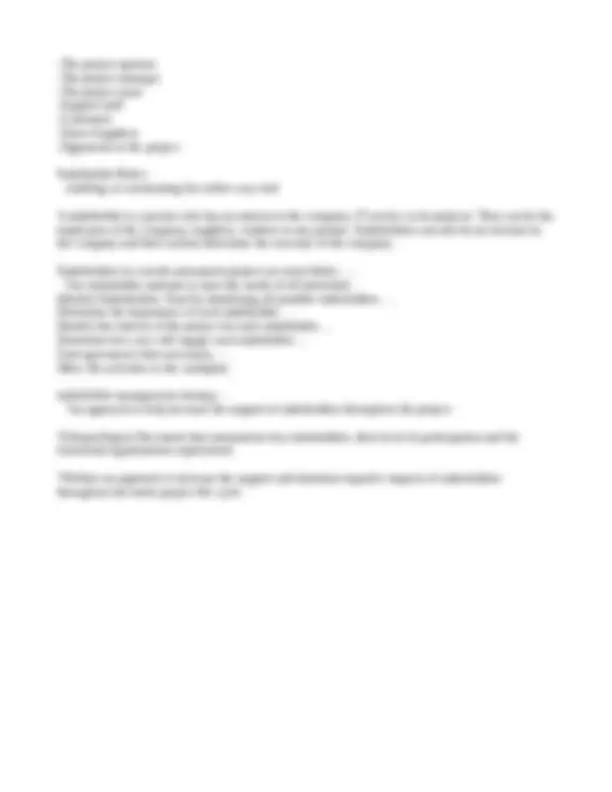


Study with the several resources on Docsity

Earn points by helping other students or get them with a premium plan


Prepare for your exams
Study with the several resources on Docsity

Earn points to download
Earn points by helping other students or get them with a premium plan
Community
Ask the community for help and clear up your study doubts
Discover the best universities in your country according to Docsity users
Free resources
Download our free guides on studying techniques, anxiety management strategies, and thesis advice from Docsity tutors
An overview of project management, including the five process groups, project lifecycle, and the role of a project manager. It also discusses program, portfolio, and operations management, and their relationship with project management. the responsibilities of a project manager and the skills required to be a good project manager.
Typology: Exams
1 / 56

This page cannot be seen from the preview
Don't miss anything!

















































Project Management - The application of knowledge, skills, tools, and techniques to project activities to meet project requirements a systemized, phased approach to defining, organizing, planning, monitoring, and controlling projects The five Project Management Process Groups are: - "Initiating, Planning, Executing, Monitoring and Controlling, and Closing" Process Groups -
1.2.3.2 Program management - Focuses on interdependencies between projects and between projects and the program level to determine the optimal approach for managing them. 1.2.3.3 Portfolio management - A portfolio is defined as projects, programs, subsidiary portfolios, and operations managed as a group to achieve strategic objectives. 1.2.3.4 Operations management - Operations management is an area that is outside the scope of formal project management as described in this guide. Is concerned with the ongoing production of goods and/or services. Ok ensures that business operations continue efficiently by using the optimal resources needed to meet customer demands. It is concerned with managing processes that transforms inputs into outputs. 1.2.3.5 Operations and project management - Projects can intersect with operations when: developing a new product, improving process, at the end of the product life, and at each close out phase. 1.2.3.6 Organizational project management (OPM) and strategies - Portfolio: aligns portfolios with strategies by selecting the right programs and projects. Programs: harmonize its components and controls interdependencies in order to realize specific benefits. Projects: enables the achievement of goals and objectives. What is the relationship between project program and portfolio management? - A program is a group of projects that are similar or related to one another, and which are often managed and coordinated as a group instead of independently. A portfolio is a group of different programs and/or projects within the same organization, which may be related or unrelated to one another. Project - A project is the lowest level in the hierarchy of project, program, and portfolio. According to the PMBOK Guide, (p13) "A project is a temporary (finite) endeavor undertaken to create a unique product, service or result." So, you can say that the nature of a project is temporary (P13- "time limited, definite beginning and end, also means the project does not include Operations, since Operations may go on perpetually and projects are "Finite", + project is "unique" - NOT been attempted before by this organization"!); once the project achieves its objective, it no longer exists, and the objective of the project is to create a unique product, or develop a system to provide you with a service or the result. For example, assume you have been given a project to set up a call center for a company. You complete the project, set up the call center, and hand it over to your client. Now your client can provide a support service to their customers. Please note that once you hand over the product to the client, your project will be completed and closed. You will disband your team; members will be separated, since the nature of the project is temporary. It is not necessary for your team members to be located in the same place; sometimes your project team may include members located outside your geographic location. In this case, you will call your team a virtual team.
*The process of managing multiple interdependent projects to improve the performance of an organization. *The centralized coordinated management of a program to achieve the program's strategic objectives and benefits. Portfolio - p14: project portfolio represents companies entire investment in projects and programs AND should always be directly aligned with Organization's strategic goals! (truest "real strategic goals) A portfolio refers to a group of related or unrelated projects or programs. A portfolio can consist of multiple programs or multiple projects. It can have multiple, dissimilar projects because portfolio management deals with two or more unrelated projects. Conversely, in program management, only related projects are managed. For example, assume you have three projects: the first is to construct a building, the second project is to conduct research on the impact of motor pollution on the environment, and the third project is to set up a call center. How are you going to manage these projects? You will manage them by keeping them under a portfolio because they are neither related nor similar to each other. Portfolio manager manages portfolios. The success criteria for portfolio is the combined performance of its components. Portfolio Management - Portfolios are managed under portfolio management. It has a bigger scope and objective than program management. There is centralized management in portfolio management, that individual's job is to identify, prioritize, and authorize the projects or programs. This centralized management manages the projects or programs to achieve the organization's strategic objectives. Portfolio managers set the priorities of projects based on the leadership's agreed-upon business objectives. They select the program or projects under a particular portfolio and make sure that they provide the most benefit to the organization. Please note, although portfolio management sets the priority of the projects or programs in a group, it does not oversee any individual project or program. Operational Management - responsible for monitoring the daily activities of the business People who monitor the day-to-day activities of the organization. The Difference Between Portfolio Management and Program Management - There are a few differences between portfolio management and program management, including: Program management manages similar projects while portfolio management manages dissimilar projects or programs. The scope of program management is broader than the project scope, and a portfolio has an organization-wide scope, which changes with the strategic objectives of the organization. The Benefits of Portfolio Management - Some benefits of portfolio management include: Optimal allocation and utilization of resources among projects or programs
Constant support to projects or programs Fewer conflicts and better communication among projects or programs Better coordination among projects or programs Summary of Project, Portfolio, Program and Organizational Management - As you move from project management towards portfolio management, the scope and objectives will become larger and larger. In project management, you perform micro-management, and in portfolio management, high-level macro-management is required. Program management and portfolio management facilitate better communication and coordination among projects and programs, resulting in enormous benefits to economies of scale and fewer risks. project lifecycle - Book: A group of project phases specified by an organization's project management methodology. The Project life cycle is made up of all of the project phases, viewed as a whole. Projects are divided into phases in order to create a logical management and decision points. See phase for more info... "Initiating, Planning, Executing, Monitoring and Controlling, and Closing" A collection of generally sequential and sometimes overlapping project phases whose name and number are determined by the management and control needs of the organization or organizations involved in the project, the nature of the project itself, and its area of application A collection of project phases, such as concept, development, implementation, and close-out 3.0 Role of a Project manager? - Project managers play the lead role in planning, executing, monitoring, controlling and closing projects. They are accountable for the entire project scope, project team, resources, and the success or failure of the project. A project manager is a person who has the overall responsibility for the successful initiation, planning, design, execution, monitoring, controlling and closure of a project. ... The project manager should make sure they control risk and minimize uncertainty. what a good project manager is responsible for! - PMGuide: The project manager is is the person assigned by the performing organization to lead the team that is responsible for achieving the project objectives. A project manager is a leader first of all!
SM Senior manager FM Functional Manager St Stakeholder Sp sponsor PO Prgm M program manager Project Manager's sphere of influence - p108 PM must proactive and influence the factors that cause change. p112PM should work proactively to Identify and influence the factors that cause change. Overall goal of Scope mgt are to define the need, to set stakeholder expectations, deliver to those expectations, to manage change and minimize surprises so that product ultimately gain approval. p149: PM should influence the factors that cause change. sphere of influence - Outer Band: Regulatory Agencies Next band: Customers/users Business Partners Sellers/suppliers Next band: Functional managers Operational Mngers next band: Portfolio manager program manager next band in: Sponsor Inside circle: Project manager PM team Project Team Mems Phase - Book: a grouping of project activities. Many projects are divided into two or more phases in order to provide a point where the deliverables can be evaluated. Phases are separated by exit gates or kill points where someone who does not directly work with the project (the gatekeeper) evaluates the deliverables to determine whether or not the next phase is initiated. Phases should not be confused with process groups. Tailor - Tailor, in project management, is the act of choosing the process, related inputs and outputs of the project carefully to determine the subset of the processes to be included in the management approach of the project. It also involves adapting the specifications and requirements of the project to the current needs of the operation. To tailor a project, reviewing, modifying and supplementing the project data is usually done. This project management process ensures that the project is performed in accordance to the requirements of the organization. This process is intended to aid the project management team in planning, controlling and governing the use of the project and deliverables appropriately so that the project team can work in the project deployment. Examples of tailoring that are common in project management include the addition and removal of tasks and work products, changing milestones and their state of completion, responsibilities for review and approval and detailed procedures for performing measurements and managing requirements.
Project Human Resources Management:• Are required skills available in-house to complete this project or will resources need to be hired?• Will the project team be co-located or virtual? • Have they worked together previously? Project Communications Management:• Will project team members be allowed to directly communicate with stakeholders or will all communication need to go through the project manager?• What are the preferred communication methods of the project team and stakeholders? Project Risk Management:• What would be the impact to the organization if the project were to fail?• How much risk management is "right" for the project? Project Procurement Management:• Will the project management team have the authority to sign contracts or will this be done by a procurement or legal department?• What level of approval will the project team have for purchases ($100, $1,000, $10,000, etc.)? Project Stakeholder Management:• Are the Stakeholders physically located near the project?• What is the anticipated involvement of the stakeholders? Document the Project Tailoring Process - As part of the project you need to document the tailoring process approach in the project management plan. As the processes are tailored you also need to document how each process was tailored and why it was added, removed, or revised. This serves two functions. One is to document all of the adjustments made as part of the tailoring process to have a good record of the project for close out purposes. The second is to show which tailored processes worked well, and which ones may need further adjustment for future projects. By documenting the tailored processes, process tailoring guidelines and project tailoring checklists can be developed (or improved upon if already existing) to improve the process of tailoring for future projects within the organization. Re-Evaluate Project Management Processes - Just as with many project management processes, you can't just tailor a process and walk away. As the project progresses, it is vital to re-evaluate the processes being used to determine if the tailoring is working as planned and if additional adjustments are necessary. This can be completed formally at the start of a new phase if this is a phased project or even informally as part of the project status meetings. No matter the method you chose to re-evaluate, document the approach and the results both as part of your project documentation. Project process tailoring is a good project management practice that helps ensure a successful project outcome. A project manager should not blindly apply a methodology, but instead should evaluate the existing processes, assess the project to be completed, document any process tailoring completed, and re-evaluate the tailoring process as the project proceeds. Here we have provided a high level project process tailoring method that you can apply to your projects. Define a typical project lifecycle - I: A project life cycle is the sequence of phases that a project goes through from its initiation to its closure. The number and sequence of the cycle are determined by the management and various other factors like needs of the organization involved in the project, the nature of the project, and its area of application. Functional Manager - 681: FM is a manager of a department or functional group within an organization. FMs are vital to most companies since they have a deep expertise within a given area and perform the human resource management duties for the employees of their departments. PrjMgrs experience most of their conflicts with Functional managers.
p19: FM is the departmental mgr in most orgs, like mgr of engineering, director of marketing, or IT mgr. FM usually "owns" the resources that are loaned to project and has HR responsibility.FM may be asked to approve the overall project plan. FM can be rich source of expertise and info available to PM. Also FM most likely person with whom PM experiences conflict. 372: In a matrix org, team members report to both the PM and the FM, can sometimes cause confusion and can lead to conflict on a project and withing the Org. 369: Func Mgr has resource responsibilities in a Matrix Org. In Matrix Org structure PM and FM secure resources. Functional Organization (also pg 365, 372, 681) - A form of organizational structure. Functional organizations are traditional organizations with hierarchical reporting structures. Departmentalization around specialized activities such as production, marketing, and human resources. A hierarchical organization where each employee has one clear superior, and staff are grouped by areas of specialization and managed by a person with expertise in that area. Why is an Organizational Structure Needed? - The market is competitive; therefore, the organization should adapt to market demand and be responsive. Organizations with poor structure will not survive. A well-defined structure helps the organization realize its potential and support its objectives. For example: Let us say your organization is producing a product. Your customers are satisfied and not very demanding; what kind of organizational structure will you select? You will select the functional organizational structure because it supports production operations. Let's consider another case. Suppose your organization has ten employees and deals with small projects. You always start looking for a new project. In this case, what kind of structure will you select? You will select the projectized organizational structure as you are dealing with projects. Now, the final case. Your organization is enormous. The work environment is dynamic. Customer requirements and market demands are always changing. What kind of structure will you select? You cannot select the functional organization because it does not allow for quick changes to its operations. You also cannot select the projectized structure. Although it supports a dynamic nature, this is not enough. Your organization is big and you need permanent departments to keep your organization functioning. This is not possible with a pure projectized organization. Therefore, you will select a matrix organizational structure. It has the qualities of both the functional and projectized organizational structure and will support your operations and help achieve the organization's objectives. Types of Organizational Structure The type of structure depends on many factors, such as governing style, leadership style, workflow, hierarchy, and many more. The PMBOK Guide defines eight organizational structures: Organic or Simple Organization Functional or Centralized Organization Multi-divisional Organization
Organizational culture Type of organizational structure Internal political conditions Available resources Infrastructure Organizational Process Assets (OPA) - Organizational process assets can be divided into two categories. The first is for processes, policies and procedures for conducting work, which include the following: Policies Procedures Standard templates General guidelines The project management team cannot update or modify these elements usually, as they have been provided by the organization. However, a project manager can provide feedback or suggestions, and higher management can make a decision to update or modify. The second category comprises the corporate knowledge base for storing and retrieving information. For example: Risk register Lessons learned Stakeholder register Past project files Historical information These organizational process assets influence the project's success, and they keep growing as the organization becomes larger. Let us say that you are in the identify risks process. You decide to start identifying risks by using a checklist. You are not going to create this checklist from scratch; you will you look at any similar past project records to find a risk checklist and customize it as per your project requirements. This will save you a lot of time. There is a very famous saying in project management, "Why reinvent the wheel?" which means if you have something available to you, why would you try to remake it? You are free to update or modify elements from this category. Organizational process assets are used extensively in project management. It is the responsibility of the project management team to look for any relevant documents in historical records before starting to build something from scratch. The Difference between Organizational Process Assets and Enterprise Environmental Factors There are many differences between organizational process assets and enterprise environmental factors. Organizational process assets help organizations to improve their processes, help project management teams to learn, and share best practices by using a collective knowledge base. On the other hand, enterprise environmental factors may or may not help your organization. These are the conditions in which your organization has to work and do not fall under the control of the project management team. For example, if the government increases taxes, it will affect your profits negatively; however, if they decrease taxes, your profits will increase. Moreover, enterprise environmental factors are not easy to change; you have to live with them. Organizational process assets can be customized according to their suitability and they make the project management team's life much more comfortable.
It is important to note that organizational process assets always support the project team, while enterprise environmental factors can help or hinder. OPA ASSETS - An asset is defined as a useful or valuable entity or property owned by a person or company, which has value and is available to meet debts, commitment, or legacies. Basically, assets are something that you can own, keep, and make use of at any point in time. Examples of assets are numerous; you can have a car, which helps you move around, a house to live in, a computer to work on... the list is endless. In the same way, organizations also have assets that help them achieve their goals. Here these assets are called organizational process assets. These OPAs are inputs of almost all processes of the PMBOK Guide. The project management team may modify these OPAs according to their requirements. Once the project has ended, these organizational process assets can be stored in a central repository so that they can be used whenever required for any future projects. Organizational Process Assets - Organizational process assets include any of the organization's process assets that may be used to ensure project success. They generally fall into two categories: Processes, guidelines, and procedures, such as: organizational standard processes, standardized guidelines, templates The corporate knowledge base, such as, lessons learned, historical information, past project files (I call this: The Repository of Goodness) Organizational process assets are an input to 38 of the 47 processes. Example As we started the project to develop PMI-ACP (Agile Practitioner) courseware, for organizational process assets, we leveraged our course book templates that are used for all of our course materials. In addition, as we developed our approach, we took into consideration the lessons learned from our past courseware development projects. Regarding enterprise environmental factors, we took into consideration the market demand for Agile certifications, the expertise that resided in our immediate development team, and the resources that were available to us. Summary Enterprise environmental factors are the internal and external influences on our project, such as the corporate culture or the financial environment. Organizational process assets are the procedures, guidelines, templates that we can use on our project as well as the corporate knowledge base, such as past project reports and lessons learned. Distinguish between organizational systems - book p710 system: The rules, processes, procedures, people, and other elements that support an outcome or process. Several systems are defined in project management, including the project management information system, the change control system and the work authorization system. project management information system - *An integrated tool used to gather, integrate and disseminate the outputs of the project management processes - PMBOK® Guide 5th Ed., p. 92 *An information system consisting of the tools and techniques used to gather, integrate, and disseminate the outputs of project management processes. It is used to support all aspects of the project from initiating through closing, and can include both manual and automated systems.
Project charter, assumption log, Project management plan, issue log, lesson learned register, Work performance reports, change requests, project documents updates (change log) , final report, project documents updates. Work Authorization System - *A subsystem of the overall project management system. It is a collection of formal documented procedures that defines how project work will be authorized (committed) to ensure that the work is done by the identified organization, at the right time, and in the proper sequence. It includes the steps, documents, tracking system, and defined approval levels needed to issue work authorizations.
considered to be a coordinator or an escalator. In a balanced matrix, the power is equally balanced between the project manager and the functional manager. Understand purpose and activities of a Project Management Office (pg20) - AKA Project Mgt Office (PMO) refers to a department that can support project managers with methodologies, tools, training, etc,. or even ultimately control all of the organization's projects. Ususally the project office serves in a supporting, defining standards, providing best practices, and auditing projects for conformance. "Positive Light" , Ex: IGBU office Purpose and activities of PMO: - PMOs take on various tasks in an organization, but here are the six most important functions of a PMO: Ensure PM standards and quality across the organization. ... Strategic project management. ... Operative assistance. ... Coordination of projects and resources. ... Increasing effectiveness and efficiency. ... Project coaching and training. A PMO makes sure company procedures, practices and operations go right — on time, on budget and all in the same way. "PMOs are there to ensure project and program success, and that's critical because organizations deliver value through projects and programs, Recognize the hierarchy of Projects (p13), programs(p14) and Portfolios (p14) - Primary function of a Project Manager (p18, 24, 375, 516, 696) - triple constraint theory - The triple constraint theory, also called the Iron Triangle in project management, defines the three elements (and their variations) as follows: Scope, time, budget.(cost). quality and risk are also factors that are linked to the triple constraint. Bp712: the intersection of scope, time and cost on a project. the Triple constraint emphasizes that one of these cannot change without affecting at least one of the other two. Difference between leadership and management - Leadership: Attempting to motivate/influence people Mgmt: Directing people toward organizational goals Management maintains the status quo and keeps things as they are. Leadership changes the status quo and moves people in a new direction. Page 43, 61 Leadership: influence relationship, done by leaders and collaborators, episodic affair, does not need a position to operate. Management: authority relationship, managers or subordinates, done continuously, requires positon
Integrate Change Control. Close Project. project management processes - *"Initiating, Planning, Executing, Monitoring and Controlling, and Closing" *Those processes that ensure the effective flow of the project throughout its life cycle, including the tools and techniques involved in applying the skills and capabilities described in the Knowledge Areas. *used to plan and execute large projects such as the construction of a new factory or the production of complex products such as airplanes 7 project management processes of integration - Develop Charter, Develop Project Management Plan. Direct and manage project Work, Manage Project knowledge, Monitor and control Project Work, Perform integrated Change control, close project or phase. 4.1 Purpose of project integration management: defined as: - p63 defined as the practice of making certain that every part of the project is coordinated.. **Cant delegate this! PM Responsibility! PM is Ultimately Responsible for entire project. High Level VIEW of Project. Integration: changes made in any one are of the project must be integrated into the rest of the project.. PHILOSOPHY: 1. execution can be messy, buffer team, PM should make decisions instead of meeting every 5 min. 2. process not straight start to finish. Revisitin alot! 3. integration processes need tailored to fit the size and complexity of a project Integration Management - *processes and activities to identify, define, combine, unify, and coordinate the various processes and project management activities *includes processes/activities needed to identify, define, and coordinate various processes and project management activities. Book p63: system working together, represents the whole forest. 7 processes focus on the larger, macro things. These 7 are the HEART of managing the Entire Project In integration management the PROJECT is Started, PM assembles the Project PLAN, Executes the plan, and verifies the results of the work, and then the project is closed, knowledge is captured, all at same time PM must prioritize different objectives competing for time, resources and keep team focused on completing the work. 7 Integrated Management processes, how they fit together and Impact each other. Application Area - an area of expertise, industry, or function where a project is centered. or A category of projects that have common components, often categorized as technology projects, customer projects, or industry projects (IE: Architech, IT, Healthcare,
cultural and social environment - Defines how a project affects people and how those people may affect the project. Cultural and social environments include the economic, educational, ethical, religious, demographic, and ethnic composition of the people affected by the project. Deliverable - Product service or result created by a project! Any unique and verifiable product, result, or capability to perform a service that is required to be produced to complete a process, phase, or project. General management skills - These include the application of accounting, procurement, sales and marketing, contracting, manufacturing, logistics, strategic planning, human resource management, standards and regulations, and information technology. International and political environments - Consideration of local and internal laws. languages, communication challenges, time-xone differences, and other non-collocates issues that affects a projects ability to progress interpersonal skills - Ability to motivate, interact, lead and manage people concerning or involving relationships between people Progressive Elaboration - The process of gathering project details. This process uses deductive reasoning, logic, and a series of information-gathering techniques to identify details about a project, product, or solution. project - A temporary endeavor undertaken to create a unique product, service, or result. Project management office - An organizational structure that standardizes the project-related governance processes and facilitates the sharing of resources, software, training, templates, methodologies, tools, techniques., Policies, dispute resolutions, communications, and other services. Project portfolio management - The management and selection of projects that support an organization's vision and mission. It is the balance of project priority, risk, reward, and return on investment. This is a senior management process. Subproject - A smaller portion of the overall project created when a project is subdivided into more manageable components or pieces.. Often is contract work and helps keep the overall project moving. physical environment - The physical structure and surroundings that affect a project's work. change management - *Process of making sure changes are made smoothly and efficiently and do not negatively affect systems reliability, security, confidentiality, integrity, and availability.